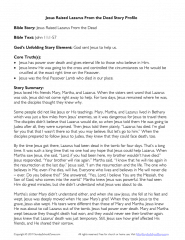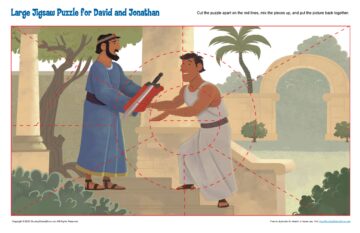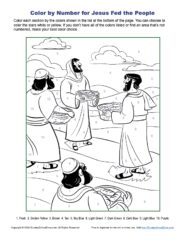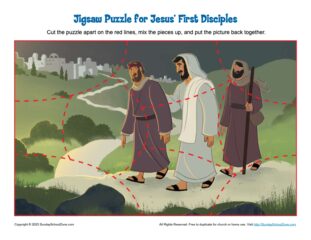Jesus Raised Lazarus From the Dead Story Profile
This Jesus Raised Lazarus From the Dead Story Profile provides a simple overview/summary of the story (for kids) along with commentary (for parents and leaders), points of interest, and an approximate date for the story. A printable PDF for this profile is available here and all related activities are listed here.
Bible Story: Jesus Raised Lazarus From the Dead
Bible Text: John 11:1-57
God’s Unfolding Story Element: God sent Jesus to help us.
Core Truth(s):
- Jesus has power over death and gives eternal life to those who believe in Him.
- Jesus knew He was going to the cross and controlled the circumstances so He would be crucified at the exact right time on the Passover.
- Jesus was the final Passover Lamb who died in our place.
Story Summary:
Jesus loved His friends Mary, Martha, and Lazarus. When the sisters sent word that Lazarus was sick, Jesus did not come right away to help. For two days, Jesus remained where he was, and the disciples thought they knew why.
Some people did not like Jesus or His teachings. Mary, Martha, and Lazarus lived in Bethany which was just a few miles from Jesus’ enemies, so it was dangerous for Jesus to travel there. The disciples didn’t believe that Lazarus would die, so when Jesus told them He was going to Judea after all, they were surprised. Then Jesus told them plainly, “Lazarus has died. I’m glad for you that that I wasn’t there so that you may believe. But let’s go to him.” When the disciples prepared to follow Jesus to Judea, they knew that they could face death, too.
By the time Jesus got there, Lazarus had been dead in the tomb for four days. That’s a long time. It was such a long time that no one had any hope that Jesus could help Lazarus. When Martha saw Jesus, she said, “Lord, if you had been here, my brother wouldn’t have died.” Jesus responded, “Your brother will rise again.” Martha said, “I know that he will rise again in the resurrection at the last day.” Jesus said, “I am the resurrection and the life. The one who believes in Me, even if he dies, will live. Everyone who lives and believes in Me will never die ⎯ ever. Do you believe this?” She answered, “Yes, Lord, I believe You are the Messiah, the Son of God, who comes into the world.” Martha knew Jesus was powerful. She had seen Him do great miracles, but she didn’t understand what Jesus was about to do.
Martha’s sister Mary didn’t understand either, and when she saw Jesus, she fell at his feet and wept. Jesus was deeply moved when He saw Mary’s grief. When they took Jesus to the grave, Jesus also wept. His tears were different than those of Mary and Martha. Jesus knew He was about to call Lazarus out of the tomb. Jesus had power over death. Mary and Martha wept because they thought death had won, and they would never see their brother again. Jesus knew that Lazarus’ death was just temporary. Still, Jesus saw how grief affected His friends, and He shared their sorrow.
“Take away the stone,” He said. Then Jesus lifted His eyes and spoke to God. “Father, I thank you that you heard me…” And then with a loud voice, Jesus said, “Lazarus, come out.” And he did! Lazarus, who had been dead for four days, walked out of the tomb.
We don’t know what immediately happened next. We don’t know how the sisters reacted when they saw their brother brought back to life, or how Lazarus described his experience to the people around them.
We DO know that when Lazarus left the tomb, many more people believed in Jesus because of this, but some did not and were upset. Jesus’ enemies began to plot how they could kill Jesus. They were afraid that the Roman soldiers would come, take the temple, and destroy their land. The high priest said, “. . .it is to your advantage that one man should die for the people rather than the whole nation perish.” They would rather Jesus die than face the Romans.
The religious leaders thought they were in charge, but they weren’t. Jesus already knew what was going to happen. He knew He would die as a sacrifice, the final Passover Lamb, and that His death would pay the price for our sin. It was all happening just as God had planned because God loved us too much to let our sin separate us from knowing His love. The death and resurrection of Jesus would ultimately bring glory to God and salvation to God’s people! And now we see that Jesus has power over death and gives eternal life to those who believe in Him.
Commentary:
It is no coincidence that this story falls at the very center of John’s Gospel. The event recorded here represents a decisive turning point for Jesus’ ministry and His road to the cross. John’s account of this story points to the delayed timing of Jesus’ trip to Bethany in four distinct references, underscoring the strategic timing of this event.
It’s important to note that the story provides an important explanation for the final decision by the Jewish leadership to kill Jesus. Any treatment of the story, therefore, should include the entire chapter in order to see how Lazarus’ “resuscitation” (see Point of Interest below) was part of Jesus’ plan to be crucified on the Passover. He was carefully managing the events of these days in order to bring things to the inevitable “head” at just the right time.
The story begins with Jesus and His disciples in an unidentified place, though it is likely He is still “across the Jordan… where John had been baptizing earlier” (10:40). What’s important to understand here is that Jesus had withdrawn from Jerusalem at the end of chapter 10 because of the efforts to stone Him. They were ready to kill him then, but the timing wasn’t right. Only the Passover would do, so Jesus “departed” back “across the Jordan.” We’re not told just how long Jesus and His disciples stayed there, but the withdrawal was strategic. It simply wasn’t time yet for Him to be crucified.
Jesus received a message from Mary and Martha reporting that Lazarus, their brother, was sick. Implied here is the request that Jesus would come quickly. Jesus, however, makes a deliberate decision to wait two days before beginning the day long journey. John is careful to note Jesus’ explanation that “This sickness will not end in death but is for the glory of God…” (11:4). This is the first instance where Jesus’ delayed timing is critical to the story. His delay is deliberate and John notes it with a clear explanation that Jesus knew what He intended to do.
When Jesus finally announces that they would “go to Judea again” (11:7), the disciples are quick to point out that “just now the Jews tried to stone You…” (11:8). This places the event squarely in the context of the hostility toward Jesus, so the story is “bookended” on the front end with a story of an attempt on Jesus’ life (10:39) and will be “bookended” on the back end with the plot to kill Jesus (11:53). This is important because it helps us see that the story isn’t merely a story of Jesus performing a spectacular miracle. It’s a story that explains why the hostility toward Jesus so quickly reached the point of planning His murder.
After Jesus explains to His disciples that Lazarus had died and that they were going “to him” (11:15), Thomas says to the other disciples, “Let’s go so that we may die with Him.” Clearly the disciples understood the dangers that awaited them in Bethany, a town just two short miles from Jerusalem (11:18). This isn’t just another miracle story. This is about Jesus’ rapidly approaching crucifixion.
As they approached Bethany, Martha heard Jesus was close and went to meet him. She immediately declares, “Lord, if You had been here, my brother wouldn’t have died” (11:21). This is the second reference to Jesus’ delayed timing. Her statement is understandable. She believed Jesus could have healed Lazarus, but she is not imagining that Jesus might bring him back to life. Implicit in her comment is the conviction that it was now too late for Jesus to do anything. This was the obvious general conviction of everyone in the story. Death, they believed, was beyond Jesus’ power to overcome. He could heal and prevent death, but He could not overcome death and restore life.
Even when Jesus plainly states, “Your brother will rise again” (11:23), Martha does not receive the statement as a notice of what Jesus was about to do. Rather, she replies that yes, “he will rise in the resurrection at the last day” (see Point of Interest below). Notice again the prominence of time in the ongoing narrative. Martha assumes resurrection will come later; not at that moment. Time plays a very practical and important role in the entire story.
It is here that Jesus gives us one of the Bible’s greatest declarations… “I am the resurrection and the life. The one who believes in Me, even if he dies, will live. Everyone who lives and believes in Me will never die—ever.” (11:25-26a). This is an incredibly rich statement that shifts the nature of life and resurrection from a thing and an event to a person. At the heart of the Christian faith is this central conviction… real life is found in the person of Jesus, not the circumstances of this worldly existence.
Even death is redefined here by Jesus as a temporary reality for the one who believes in Him. In the common mind, death is the final and absolute victor. Only in the resurrection to come “at the last day” will death be overcome. Jesus demolishes that notion. In Jesus, death becomes almost inconsequential… “even if he dies,” he will live. In reality, according to Jesus, the one who believes in Him “will never die—ever.” This brings the future expectation into the present time. Jesus has conquered death, not just in the future, but NOW!
It’s hard to overstate the significance of this radical shift in thinking. The New Testament teaching regarding life is that Jesus has already ushered in the reality of God’s Kingdom and the arrival of life HERE and NOW. We can still hear the words of Jesus as He corrects Martha’s thinking… “Martha, you’re thinking about resurrection in the future. I’m telling you that the resurrection is HERE, NOW. I AM THE RESURRECTION!” Even children need to be helped to understand that life is not found in the circumstances of this world. Jesus lifts us above circumstances to life that is not governed by the circumstances of this world.
The narrative continues, however, to reveal that this story is about more than Jesus’ conversation with Martha (as earth-shaking as it is). Next, Mary comes to meet Jesus and she, too, makes the identical claim, “Lord, if You had been here, my brother would not have died” (11:32). John records the identical statement to underscore the point… Jesus’ timing is critical to the story. This is the third reference to Jesus’ delayed timing. A pattern is definitely developing that we should notice!
John records nothing of the conversation between Jesus and Mary beyond her initial claim. Rather, John points to the sorrow and emotion surrounding the entire situation. Jesus is also moved by the sorrow. He is not grieving for Lazarus’ loss. He knows what is about to happen. Rather, Jesus is grieving with those who perceived the loss as permanent. No doubt He was also grieving over the power of death that held humanity in its grip. He knew what was about to happen just as He knew what He would soon accomplish on the cross, but the final blow to death will not come yet. Jesus will defeat sin and death on the cross, but death will continue to be a present reality for a season. Until then, death and the sorrow it brings will be a reality that moves us (and Jesus) with true emotion.
Those observing the interaction between Jesus and the two sisters as well as His own emotional response now give voice to the same question as Martha and Mary… “Couldn’t He who opened the blind man’s eyes also have kept this man from dying” (11:37)? This is the fourth reference to Jesus’ disappointing timing. The pattern is now unmistakable. The fact that Jesus tarried and, therefore, missed the opportunity to prevent Lazarus’ death is a central feature of this dramatic narrative.
For Mary, Martha, and the crowds, the conclusion was crushingly sad… Jesus could have made a difference had He been here. Now it’s too late. For John’s readers, including those of us reading it today, the conclusion is more puzzling. Why did He wait? The answer will become more clear as the story progresses.
The dramatic moment in the story comes as Jesus arrives at the tomb and calls for the stone to be removed. Martha objects, noting that the body was “already decaying.” Martha was still not expecting Lazarus to be raised. In fact, the length of time Lazarus had been in the tomb made it beyond any reasonable expectation. That’s part of the point of John’s narrative. Lazarus was dead beyond any doubt. He was so dead that resuscitation was out of the question. It was simply impossible, but not for Jesus.
Jesus prays and then calls for Lazarus to “come out.” This was a “do or die” moment in Jesus’ ministry. There was a large crowd there. Many of the crowd were not believers and some were, no doubt, hostile toward Jesus. This very public event could not be explained away by either Jesus and His disciples (if He failed) or by His enemies (if He succeeded). What happens next would set the course for the coming days. If the only thing to come out of the tomb was the smell of death, then Jesus could be dismissed as a crazy man. It would be a failure and a very laughable, public failure at that. On the other hand, if Lazarus steps out of that tomb, then it will be obvious that Jesus is not like any other man. Then those people will have to make a decision to either believe that Jesus is the Messiah they’ve been waiting for, or that He must be killed.
Lazarus does, indeed, come out of the tomb. Jesus calls for someone to “Loose him and let him go.” John sums up this incredibly dramatic event in only one verse. It would have been easy to go on to explain the response of Lazarus, his sisters, and the crowd. Wow! Words would fail to describe what must have happened next. But, rather than describe those responses, John quickly changes to the response of the Pharisees and the Sanhedrin.
This somewhat surprising and abrupt shift gives us an important clue about the purpose of the story. This story isn’t so much about encouraging faith in the reader (even though it certainly does that) as much as it explains how the Sanhedrin came to the important decision to kill Jesus. It is this decision that creates the “bookend” at the back end of the story. By placing the story of the attempted stoning at the beginning of the story, by weaving references to the dangers of Judea throughout the story, and by closing the story with this decision by the Sanhedrin, John makes it clear that this story is the turning point in the larger narrative of Jesus’ ministry.
John gives significant attention to the meeting of the Sanhedrin. It is here that John articulates a clear, albeit brief, statement of the doctrine of “substitutionary atonement.” He places the statement in the mouth of the High Priest, Caiaphas, who doesn’t intend to make a theological statement as much as a political statement… “It is to your advantage that one man should die for the people rather than the whole nation perish” (11:50). John goes on to expand and apply this statement to Jesus in the Christian sense… “Jesus was going to die for the nation, and not for the nation only, but also to unite the scattered children of God” (11:52).
This declaration by John may, in fact, be the key point of the entire story… Jesus delayed going to Bethany in order to demonstrate “the glory of God” (11:4) by raising Lazarus from the dead. In turn, this would provoke the Sanhedrin to plan His death which Jesus intended to happen on the Passover. His crucifixion would become a substitutionary death on behalf of “the nation” just as the blood of the Passover Lamb was the substitutionary means by which Pharaoh was vanquished and the people of Israel freed.
The raising of Lazarus demonstrated Jesus’ power over death and foreshadowed His own victory over death in the resurrection a short time later. The story of Jesus raising Lazarus was, therefore, the perfect event to make John’s larger point. Jesus would conquer death by dying a substitutionary death as the Passover Lamb. His death did not come as a surprise to Him, but rather it was an event He orchestrated by managing the circumstances leading up to the crucifixion.
This becomes even more apparent as John closes the chapter with the question of whether Jesus would attend the Passover Festival… “He won’t come to the festival, will He” (11:56)? The very question reveals their failure to understand that Jesus, not the Sanhedrin, is in control of the agenda. Yes, He went to the festival. What’s more, He became the final and ultimate Passover Lamb.
This is a long story that needs to include the entire chapter if it is going to be understood properly. The key points to understand and communicate to children are…
- Jesus knew He was going to the cross and controlled the circumstances so He would be crucified at the exact right time on the Passover.
- Jesus was the final Passover Lamb who died in our place.
- Jesus has power over death and gives eternal life to those who believe in Him.
Points of Interest:
- Scholars will typically refer to Lazarus’ raising as a “resuscitation” rather than a “resurrection.” The distinction is made simply because Lazarus died and was raised in his same mortal body which meant he would die again, while Jesus was raised in a new body that will never perish. He is still alive!
- It was common belief among many Jews of that day that the soul of an individual might linger near the body for three days, thus maintaining the hope of resuscitation. Once the body began to decompose, however, the soul would depart and resuscitation would be impossible. The fact that Lazarus had been buried for four days would underscore the certainty of death and the unique nature of this miracle. Lazarus was dead and beyond any hope of restoration. No such obstacle would be too great for Jesus, however.
- Martha’s comment in 11:22 is not an expression of hope or faith that Jesus might yet do something about Lazarus’ death. It is probably best read as an explanation for her faith that Jesus could have saved Lazarus (11:21). So, the two verses together could be read, “Lord, I know that if You had been here, my brother wouldn’t have died, because I know that whatever You ask from God, God will give you.” It’s clear from the context, especially verse 39, that Martha did not expect Jesus to resuscitate Lazarus.
- Most Jews of Jesus’ day did believe in a future resurrection of God’s people. The Sadducees, however, were an exception and did not affirm a future resurrection (see Acts 23:6-8). The doctrine of a future resurrection is consistent with many Old Testament texts that point toward God ultimately reigning over all of creation at some future time. We should not be surprised, then, that Martha believed in a future resurrection. The doctrine affirms that the God of the Bible (Old or New Testament) is God over even death and His people will share in His victory over death.
Approximate Date:
This event probably occurred just a few weeks before Jesus’ crucifixion, probably around 30-33 A.D.
- Related Activity Links:
- Divine Power ,
- Jesus, Lazarus ,
- Grade School (Readers), Preschool (Non-readers) ,
- Jesus Raised Lazarus From the Dead




